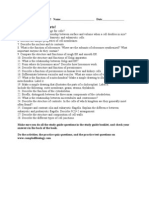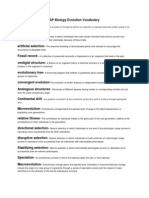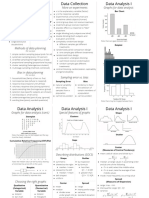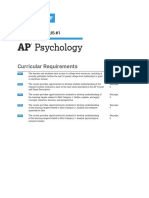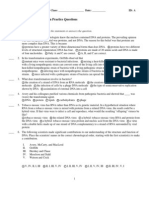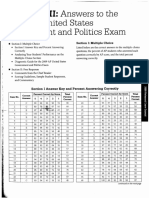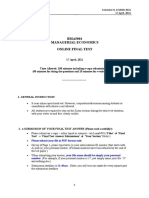100%(2)100% found this document useful (2 votes)
4K viewsChapter 1 The Science of Biology, Raven Biology 9th Edition Chapter Outline
Chapter 1 The Science of Biology, Raven Biology 9th Edition Chapter Outline
Uploaded by
maxpileckiOutline for Chapter 1 The Science of Biology for the Book Raven Biology 9th Edition. This outline also works for the 10th edition of the book.
Copyright:
© All Rights Reserved
Available Formats
Download as DOC, PDF, TXT or read online from Scribd
Chapter 1 The Science of Biology, Raven Biology 9th Edition Chapter Outline
Chapter 1 The Science of Biology, Raven Biology 9th Edition Chapter Outline
Uploaded by
maxpilecki100%(2)100% found this document useful (2 votes)
4K views10 pagesOutline for Chapter 1 The Science of Biology for the Book Raven Biology 9th Edition. This outline also works for the 10th edition of the book.
Original Title
Chapter 1 the Science of Biology, Raven Biology 9th Edition Chapter Outline
Copyright
© © All Rights Reserved
Available Formats
DOC, PDF, TXT or read online from Scribd
Share this document
Did you find this document useful?
Is this content inappropriate?
Outline for Chapter 1 The Science of Biology for the Book Raven Biology 9th Edition. This outline also works for the 10th edition of the book.
Copyright:
© All Rights Reserved
Available Formats
Download as DOC, PDF, TXT or read online from Scribd
Download as doc, pdf, or txt
100%(2)100% found this document useful (2 votes)
4K views10 pagesChapter 1 The Science of Biology, Raven Biology 9th Edition Chapter Outline
Chapter 1 The Science of Biology, Raven Biology 9th Edition Chapter Outline
Uploaded by
maxpileckiOutline for Chapter 1 The Science of Biology for the Book Raven Biology 9th Edition. This outline also works for the 10th edition of the book.
Copyright:
© All Rights Reserved
Available Formats
Download as DOC, PDF, TXT or read online from Scribd
Download as doc, pdf, or txt
You are on page 1of 10
CH1 The Science of Biology
1.1 The Science of Life
a. Amount of available data has exploded in last 25 years
i. Scientists sequencing genomes at increasing pace
ii. finding out how one cell gives rise to a complex organization
1. iology unifies much of !atural Science
a. iology is a point of convergence of natural science
b. iological Systems are most complex of all on earth
c. "unctions of chemical systems are determined and constrained by principles
of chemistry and physics
i. Study of biology doesn#t bring about new laws
d. Energy determines levels of biological organization
i. Study of thermodynamics gives info about transitions of energy
ii. complexity of living systems made possible by the sun
e. Science is becoming interdisciplinary
i. !anotechnology
ii. Several disciplines required to solve one problem
2. $ife defies simple definition
a. iology is the study of living things
i. scientists living w% gorillas for research& fossils& listen to whales
ii. 'if it moves& it#s alive' is not always true
b. (ellular )rganization
i. All organisms have 1 or more cells
ii. (ells carry out basic activities of living
iii. cells are bound by a membrane
c. )rdered complexity
i. all living things are complex and highly ordered
ii. !on living things may be complex but not ordered
d. Sensitivity
i. organisms respond to stimuli
1. pupils dilate in the dar*
e. +rowth& ,evelopment& and reproduction
i. all organisms and molecules can grow and reproduce
ii. -ereditary molecules passed on to offsprings
f. .nergy /tilization
i. organisms ta*e in energy
1. obtained from food
ii. energy spent through wor*
g. -omeostasis
i. 0aintaining constant internal conditions regardless of changing
environment
h. .volutionary adaptation
i. )rganisms interact w% one another
ii. organisms evolve to adapt to the environment
1. $iving systems show hierarchical organization
a. 2he (ellular $evel
i. atoms3 fundamental elements of matter
ii. molecules3 clusters of atoms
iii. )rganelles3 molecules 4oined together
iv. (ells3 organelles bound together by a membrane
b. 2he organism level
i. 2issue3 groups of similar cells
ii. organs3 structures composed of several different tissues that act as a
structural or functional unit
iii. organ systems3 grouping of organs
c. 2he population level
i. population3 organisms of the same species living in the same place
ii. species3 members similar in appearance and capable of interbreeding
iii. biological community3 population of different species living together
in one place
d. .cosystem $evel
i. ecosystem3 biological community and the physical habitat within
which it lives
e. 2he biosphere3 entire planet
f. .mergent properties
i. result from the way in which components interact
ii. cannot be deduced from looming at parts themselves
1. individual cell examination doesn#t provide info about animal
g. ,ifficult to define life because living world exhibits many emergent properties
1.2 The Natre of Science
a. Scientific 0ethod3 false claims as to a single way of doing science
i. confusion amongst common population
b. Science concerned w% developing increasingly accurate understanding of
environment
c. Assumptions that natural forces acting same as they have been long ago
d. Scientists attempt to be ob4ective
e. Science is a collective endeavor
i. self correcting
ii. 5f results not repeated by several scientists then it is re4ected
1. 0uch of Science is descriptive
a. )bservations lead to hypotheses& hypotheses ma*e experimentally testable
predictions
b. 0uch of science is purely descriptive
c. iology is concerned with arriving at an increasingly accurate description
of nature
d. Study of biodiversity is descriptive
i. .fforts to classify all life on earth
e. !ost im"ortant accom"lishment of 21st centry# com"letion of
hman genome
i. descriptive science
2. Science uses both deductive an inductive reasoning
a. ,eductive reasoning3 general principles to predict specific results
i. /se of geometry by .ratosthenes to estimate circumference of
earth
ii. 5f mammals defined to have hair then an animal with no hair is not
a mammal
b. 5nductive 6easoning3 specific observations to construct general scientific
principles
i. 7oodles have hair& terriers have hair3388 All dogs have hair
ii. leads to generalizations that can later be tested
iii. !ewton and acon used info from particular experiments to
determine how the earth wor*s
iv. ,rosophilia melanogaster3 some genes cause dramatic changes in
developmental fate
1. in isolation it was determined that similar genes found in
humans and other mammals
2. generalization that homeobox genes act as switches to
control developmental fate
1. -ypothesis3driven science ma*es and tests predictions
a. if proposals inconsistent with observations then re4ected as untrue
b. Hy"othesis3 proposition that may be true
c. iterative# a hypothesis can be changed and refined with new data
i. +eorge eadle and .dward 2atum studied nature of genetic
information
1. 'one3gene% one3enzyme'
2. refined to 'one3gene% one polypeptide'
1. later specified that one gene can define more than one
polypeptide
d. Testing Hy"otheses
i. e$"eriment# test of a hypothesis
ii. hypotheses
1. no light b%c light burned out& light switch turned off& or
going blind
2. experiments done to eliminate possibilities
e. Establishing Controls
i. variables3 factors that influence processes
ii. to evaluate hypotheses about one variable all others must be
constant
iii. 2 parallel experiments
1. test experiment3 one variable altered
2. control experiment3 all variables *ept constant
iv. (hallenge of experimental science in designing control
experiments to isolate particular variable
f. %sing &redictions
i. scientific hypothesis must be valid and useful
ii. if ma*es a prediction then the hypothesis may be tested
iii. more experimentally supported predictions ma*e hypothesis more
valid
iv. Ntrient Broth
1. exposed to air becomes contaminated
2. -ypotheses9
a. inherent properties in organic molecules could lead
to spontaneous generation of life
b. preexisting microorganisms present in air could
contaminate nutrient broth
i. proved correct by louis pasteur
ii. curved nec* prevented contamination
:. 6eductionism brea*s large systems into their component parts
a. 'edctionism3 understanding a complex system by reducing it to its
wor*ing parts
i. approach of biochemistry
1. unrevealing complexity of cellular metabolism by
concentrating on individual pathways and specific enzymes
ii. has limits
1. enzymes behave differently in isolationism and normal
cellular context
a. some behaviors cant be predicted
iii. examination of 6!A is reductionism
1. doesn#t lead to predictions about nature of protein synthesis
2. (anadian goose and floc* example
5. iologists construct models to explain living systems
a. +enetics construct models of interacting networ*s of proteins that control
gene expression
i. 7opulation biologists construct models of evolutionary change
ii. (ell biologists build models of signal transduction pathways
iii. Structural biologists build models of proteins and macromolecular
complexes
b. provides way to organize thoughts about a problem
c. farther away from extreme reductionism approach
d. more *nowledge leads to sophisticated models
i. modeling of bacteria cell
e. 2he nature of scientific theories
;. 2he nature of scientific theories
a. theory# proposed explanation for some natural phenomenon
i. based on general principle
ii. secondary meaning3 body of interconnected concepts& supported by
scientific reasoning and experimental evidence& that explains facts
in some area of study
iii. e$am"le3 quantum theory brings together set of ideas about nature
of universe
b. theories are solid ground in science
c. general public theory means lac* of *nowledge
d. 0odern evolution theory unifies biology as a science
e. (ey is ho) )ell a hy"othesis fits an observation
<. 6esearch can be basic or applied
a. 5n past science was an orderly sequence of steps
b. basic research3 extends boundaries of what we *now
i. provides scientific foundation used by a""lied science
1. a""lied science done by someone employed in the industry
c. results published in scientific 4ournals
i. undergo "eer revie) *evaluation of results=
1. provides starting point for testing of reproducibility of
experimental results
1.+ ,n E$am"le of Scientific -n.iry/ 0ar)in and Evoltion
a. theory of evolution explains how organisms on earth have change over
time and acquired a diversity of new forms
b. Charles 'obert 0ar)in
i. .nglish naturalist
ii. 1> years of study
iii. 1n the 1rigins of S"ecies by !eans of Natral Selection
1. 2he idea of evolution existed prior to ,arwin
a. 5n ,arwin#s time people believed that organisms and structures resulted
from the (reator
i. unchangeable over time
b. .arlier naturalists believed that change must#ve occurred3 evoltion
c. Natral Selection coherent& logical explanation for process of evolution
i. proposed by ,arwin
2. ,arwin observed differences in related organisms
a. 5 year expedition on -0S eagle around coast of south america
b. srudied plants and animals
c. (haracteristics of similar species varied from place to place
i. 6esulted form migration from one area to another
ii. 1: species of finches on various islands in +alapagos
1. variations in bea*s
a. caused by variations in food
2. assumptions that common ancestor
iii. 0escent )ith modification# evolution
iv. (haracteristics not resembled by areas with similar climates but
by areas ad4acent to islands
1. ,arwin proposes natural selection as mechanism for evolution
a. ,arwin#s achievement3 evolution occurs because of natural selection
b. 0ar)in and !alths
i. An Essay on the Principles of Population
1. malthus suggests population of plants and animals
increases geometrically
2. food supply for humans increases arithmetically
1. if unchec*ed& populations would soon cover entire globe
:. death limits population
a. limited number survives to produce further
offspring
ii. -ndividals "ossessing "hysical2 behavioral2 or other attribtes
that give them an advantage in their environment are more
li3ely to srvive an dre"rodce
c. Natral Selection
i. ,rtificial Selection3 animal breeders select species with
beneficial traits to produce certain characteristics
1. produces great variation of traits than natural selection
ii. Natral Selection is the same as artificial selection except occurs
freely in nature
d. 0ar)in drafts his argment
i. drafted in manuscript in 1?:2 and put away for 1; years
ii. @allace from 5ndonesia develops identical theory
iii. 2wo scientists present their ideas together at seminar in london
:. 7redictions of natural selection have been tested
a. 4ossil 'ecords
i. ,arwin predicts that these would yield intermediate lin* between
great groups of organisms
1. fishes and amphibians
2. reptiles and birds
ii. discoveries of microscopic fossils extend life on earth bact to 1.5
AA
b. ,ge of Earth
i. ,arwin predicted that .arth must be very old
1. evolution requires a long time
ii. Some physicists argued earth is few thousands years old
iii. 'adioactive decay proved the physicists wrong
c. !echanisms of Heredity
i. ,arwin criticized for heredity
1. could not explain himself b%c no one had concepts of genes
and heredity
2. /nderstanding of laws of heredity caused criticism of
,arwin to vanish
ii. +eorge 0endel#s pea experiment at simmilar time
iii. +enetics not established until 2>th century
d. Com"arative anatomy
i. 0any vertebrates have the same bones
1. evidence for darwin#s theory
ii. homologos# same evolutionary origin& different structure and
function
iii. analogos# similar function but different evolutionary origins
1. birds and butterflies
e. !oleclar evidence
i. comparing of genomes
1. sequence of genes
ii. specifies degree of relationship among groups
iii. evolutionary changes involve continuing changes to ,!A
1. 0ost simmilar hemoglobin in 6hesus mon*eys and
humans
2. simmilar 1:;3amino3acid hemoglobin 3chain
iv. "hylogenetic tree# pattern of descent obtained
1. represents evolutionary history of gene
2. ,!A changesB footprints of evolutionary history
1.5 %nifying Themes in Biology
1. (ell theory describes the organization of living systems
a. cells# life#s basic units
i. ,iscovered by 6obert -oo*e
b. Schleiden and Schwann
i. cell theory# all living organisms consists of cells
2. 2he molecular basis of inheritence explains the continuity of life
a. deo$yriboncleic acid *0N,63 information that specifies what a cell is
li*e
b. Ncleotides# building bloc*s of ,!A
i. : are found in ,!A
ii. Specific sequences of !ucleotides ma*e up a gene
c. (ontinuity of life depends on faithful copying of cell#s ,!A
d. 7enome# entire set of ,!A instruction specifying a cell
i. -uman genome sequence has 1 billion nucleotides
1. ,ecoded in rough draft form in 2>>1
1. 2he 6elationship between structure and function underlies living systems
a. function in molecules and macromolecular dependent on structure
b. @hen we *now function of structure we can infer functions of similar
structures
c. surface receptor for insulin used for conclusion of a relationship of upta*e
of glucose in worms and humans
:. 2he ,iversity of life arises by evolutionary change
a. ,iversity classified into 1 categories
i. acteria
ii. Archae
iii. .u*arya
1. 7lantae3 have cell walls of cellulose and utilize
photosynthesis
2. "ungi3 have cell walls of chitinC obtain evergy by secreting
digestive enzymes and absorbing product
1. Animalia3 lac* cell walls& digest other organisms to obtain
energy
:. 7rotista3 unicelular eu*aryotes and algae& except yeast
5. .volutionary conservation explains the unity of living systems
a. All organisms alive have descended from a simple cellular creature
b. storage of info in ,!A common to all living things
;. (ells are information3processing systems
a. ,!A directs synthesis of cellular components& differs from cell to cell
b. (ells sense their environment
i. (ritical to function of tissues and organs in multicultural organisms
ii. 6egulate internal conditions
1. maintain p-& temp& and concentration of vital ions
<. $iving systems exist in a nonequilibrium state
a. (onstant supply of energy necessary to maintain nonequilibium state
i. !ucleic Acids and 7roteins are not polymers at equilibrium and
would by hydrolyzed
You might also like
- Unit 4 Practice TestDocument8 pagesUnit 4 Practice TestaestesNo ratings yet
- AP Comp LitDocument6 pagesAP Comp Litkyu2000No ratings yet
- Nya Sample Final ExamDocument14 pagesNya Sample Final Examjona chemistryNo ratings yet
- Unit 4 Evolution Study Guide Answers 1Document3 pagesUnit 4 Evolution Study Guide Answers 1api-32586498550% (2)
- Kami Export - Oliver Abrams - 5.1-5.2 PracticeDocument3 pagesKami Export - Oliver Abrams - 5.1-5.2 Practiceoliver abramsNo ratings yet
- Chapter 2: Modeling Distributions of Data Review: Multiple Choice: Select The Best Answer For Each QuestionDocument3 pagesChapter 2: Modeling Distributions of Data Review: Multiple Choice: Select The Best Answer For Each QuestionAN NGUYENNo ratings yet
- 10 S Mythological Creatures Dichotomous Key LabDocument2 pages10 S Mythological Creatures Dichotomous Key LabSarika BansalNo ratings yet
- 2021 Aamc 10aDocument4 pages2021 Aamc 10aNadiaNo ratings yet
- AP Bio Lab GuideDocument2 pagesAP Bio Lab GuideSteven TruongNo ratings yet
- 05 Ela30 1 Sosw Jan2018 - 20181217Document100 pages05 Ela30 1 Sosw Jan2018 - 20181217Jayden FrosterNo ratings yet
- Practice Test 6: Answers and ExplanationsDocument30 pagesPractice Test 6: Answers and ExplanationsIsi FeridNo ratings yet
- Guide To CE Marking of Structural SteelworkDocument73 pagesGuide To CE Marking of Structural Steelworkxevi00100% (1)
- Glossary of Electricity and Magnetism MidDocument3 pagesGlossary of Electricity and Magnetism MidPadmi RianiNo ratings yet
- Comparison of The English and French Versions of The Casper® Test in A Bilingual PopulationDocument10 pagesComparison of The English and French Versions of The Casper® Test in A Bilingual PopulationChristieBrownNo ratings yet
- Mendelian Genetics Concept CheckDocument6 pagesMendelian Genetics Concept CheckEthan HiettNo ratings yet
- Year of Wonders Quotes Cue CardsDocument3 pagesYear of Wonders Quotes Cue CardsLauren Stuart0% (1)
- Tsi Test ContentDocument3 pagesTsi Test Contentapi-305517815No ratings yet
- AP Psych Prac. Exam 18 33Document20 pagesAP Psych Prac. Exam 18 33caitcole99No ratings yet
- Honors Chemistry Study Guide For Semester I Final ExamDocument2 pagesHonors Chemistry Study Guide For Semester I Final ExamBilal QureshiNo ratings yet
- AP Physics 1 Algebra Based Unit 9 DC CircuitsDocument9 pagesAP Physics 1 Algebra Based Unit 9 DC Circuitsmk07 natNo ratings yet
- Ppt. AP Bio - Review of All LabsDocument76 pagesPpt. AP Bio - Review of All LabsagmailNo ratings yet
- AP BiologyDocument5 pagesAP BiologyAnil ChauhanNo ratings yet
- Lotf Final TestDocument8 pagesLotf Final TestAdam BryanNo ratings yet
- Pre-Ap Algebra 2 TestDocument6 pagesPre-Ap Algebra 2 Testapi-502440235No ratings yet
- Chapter 6 - Cell Parts!: AP Biology Cells Review!!! Name - DateDocument2 pagesChapter 6 - Cell Parts!: AP Biology Cells Review!!! Name - DateMaryam AllanaNo ratings yet
- Ap Bio Semester 1 Final ReviewDocument4 pagesAp Bio Semester 1 Final ReviewLynnie ShieNo ratings yet
- Reading Test: 65 Minutes, 52 QuestionsDocument56 pagesReading Test: 65 Minutes, 52 QuestionsSahyogNo ratings yet
- AP Biology Evolution VocabDocument3 pagesAP Biology Evolution VocabOhhgeeee100% (1)
- AP Statistics 핵심정리Document20 pagesAP Statistics 핵심정리Junho LeeNo ratings yet
- Ap Psychology Sample Syllabus 1Document7 pagesAp Psychology Sample Syllabus 1api-538860135No ratings yet
- Science Bowl Practice Questions Biology - 1Document111 pagesScience Bowl Practice Questions Biology - 1Kavita KrishnamorthiNo ratings yet
- Grammar Practice 9Document23 pagesGrammar Practice 9Zenobia AdonisNo ratings yet
- AP Calculus CDocument16 pagesAP Calculus CSNNo ratings yet
- SAT Official Guide Test 1Document49 pagesSAT Official Guide Test 1miltondengNo ratings yet
- Ap Calculus Ab-Bc Cheat SheetDocument25 pagesAp Calculus Ab-Bc Cheat SheetticoninxNo ratings yet
- Chapter 16 TestDocument8 pagesChapter 16 TestthevertabreakerNo ratings yet
- Quantum Mechanics Questions and SolutionDocument4 pagesQuantum Mechanics Questions and SolutionsudipmatthewsNo ratings yet
- Unit 2 ExamDocument7 pagesUnit 2 Examapi-110789702No ratings yet
- Pip Writing GuideDocument6 pagesPip Writing Guideapi-315292554No ratings yet
- Biology 8e - Raven - Chapter 1: A. Inductive ReasoningDocument15 pagesBiology 8e - Raven - Chapter 1: A. Inductive Reasoningmafaldina1No ratings yet
- Unit 3 - Cheat Sheet Cell Enegertics PDFDocument1 pageUnit 3 - Cheat Sheet Cell Enegertics PDFJ15No ratings yet
- Answer Key For AP Biology Practice Exam, Section IDocument13 pagesAnswer Key For AP Biology Practice Exam, Section Iapi-485795043No ratings yet
- Ap10 FRQ Physics B FormbDocument11 pagesAp10 FRQ Physics B FormbrsbasuNo ratings yet
- AP Chemistry Chapter 20 Electrochemistry Practice Free Response 1Document2 pagesAP Chemistry Chapter 20 Electrochemistry Practice Free Response 1phuonglehuuyenNo ratings yet
- SBI4U - Final Exam Review SheetDocument2 pagesSBI4U - Final Exam Review SheetXinyu He0% (1)
- X F X F F: Ap Calculus Ab Winter Term Quiz One NAMEDocument1 pageX F X F F: Ap Calculus Ab Winter Term Quiz One NAMEteachopensourceNo ratings yet
- 2009 AP United States: Chapter III: Answers To The Government and Politics ExamDocument2 pages2009 AP United States: Chapter III: Answers To The Government and Politics ExamBob KeyNo ratings yet
- Science Bowl PracticeDocument13 pagesScience Bowl PracticeOsborn AgyemangNo ratings yet
- Biology Chapter NotesDocument716 pagesBiology Chapter NotesjyothibsNo ratings yet
- Test Bank For Essential Environment The Science Behind The Stories 4th Edition WithgottDocument16 pagesTest Bank For Essential Environment The Science Behind The Stories 4th Edition WithgottbridgetlinhhlehNo ratings yet
- Activity 1.2.4Document2 pagesActivity 1.2.4MeGustaHistory33% (3)
- AP Psych TestsDocument7 pagesAP Psych TestslpftwNo ratings yet
- BC TestDocument22 pagesBC Test张书No ratings yet
- Ap Practice Exam With FRQDocument41 pagesAp Practice Exam With FRQVanessa LuoNo ratings yet
- Rhetorical Synthesis Level 2 PracticeDocument4 pagesRhetorical Synthesis Level 2 Practicebaobinh341102No ratings yet
- CommonLit Poem - I Felt A Funeral in My BrainDocument1 pageCommonLit Poem - I Felt A Funeral in My BrainDash3rNo ratings yet
- Regents Living Environment Practice Questions: New York Regents Living Environment Practice Questions with Detailed ExplanationsFrom EverandRegents Living Environment Practice Questions: New York Regents Living Environment Practice Questions with Detailed ExplanationsNo ratings yet
- Introduction To BiologyDocument4 pagesIntroduction To Biologyrommel benamirNo ratings yet
- Solution Manual For Concepts of Biology 3rd Edition by Mader ISBN 0073525537 9780073525532Document36 pagesSolution Manual For Concepts of Biology 3rd Edition by Mader ISBN 0073525537 9780073525532benjaminwolfprdiyajkcz100% (40)
- Chapter 1:ten Themes in The Study of Life: I. Energy and Life's OrganizationDocument5 pagesChapter 1:ten Themes in The Study of Life: I. Energy and Life's Organizationninado92No ratings yet
- Department of Education: Republic of The PhilippinesDocument6 pagesDepartment of Education: Republic of The Philippinesadith.mangaronNo ratings yet
- Mendelism and Deviation Form Mendel's FindingsDocument43 pagesMendelism and Deviation Form Mendel's FindingsNewsonNo ratings yet
- Impacts of Participatory Forest ManagementDocument13 pagesImpacts of Participatory Forest Managementmuzayan abdeNo ratings yet
- Proposal For Onam VannalloDocument2 pagesProposal For Onam VannalloAkash DebNo ratings yet
- Priya Singh: About MeDocument2 pagesPriya Singh: About MepanduNo ratings yet
- Ip 2 ResearchDocument10 pagesIp 2 ResearchAila MaeNo ratings yet
- BEBEIU18187 - LeThiThuyHang - AE2 Writing Midterm - Test Paper & Answer Sheet (Online) 11.2021 - Ks Test 1Document5 pagesBEBEIU18187 - LeThiThuyHang - AE2 Writing Midterm - Test Paper & Answer Sheet (Online) 11.2021 - Ks Test 1Lê Thúy HằngNo ratings yet
- Polynomials Synopsis: + BX + C Where A, B, C Are Real + BX + CX + D, Where A, B, C Are RealDocument9 pagesPolynomials Synopsis: + BX + C Where A, B, C Are Real + BX + CX + D, Where A, B, C Are RealThanveer AhmadNo ratings yet
- Writing - Exercise 6 (Writing A Report) - IGCSE AIDDocument3 pagesWriting - Exercise 6 (Writing A Report) - IGCSE AIDDonet M. ThomasNo ratings yet
- Form 2-English Yearly Plan 2021 SMK Sungai Damit, TuaranDocument3 pagesForm 2-English Yearly Plan 2021 SMK Sungai Damit, TuaranEve in BaliNo ratings yet
- CHE 311 Practice Questions Set 1Document3 pagesCHE 311 Practice Questions Set 1robertnketsangNo ratings yet
- Atomic Molecular Physics Lecture 5Document58 pagesAtomic Molecular Physics Lecture 5AnikaNo ratings yet
- A 2.8-mW Sub-2-dB Noise-Figure Inductorless Wideband CMOS LNA Employing Multiple FeedbackDocument8 pagesA 2.8-mW Sub-2-dB Noise-Figure Inductorless Wideband CMOS LNA Employing Multiple Feedbackhaoyue huangNo ratings yet
- SEMI Detiled LP in Math 5Document6 pagesSEMI Detiled LP in Math 5MonicaDelaCruzMagistradoNo ratings yet
- The Flexible Work DayDocument7 pagesThe Flexible Work Daywafaamohmed022No ratings yet
- Determination of Honey Botanical Origin - Problems and IssuesDocument2 pagesDetermination of Honey Botanical Origin - Problems and IssueselisalwchenNo ratings yet
- Ayushi MCQs On High Seas and Seabed MiningDocument4 pagesAyushi MCQs On High Seas and Seabed Miningindrajit royNo ratings yet
- Are You A Thermometer or Thermostat LeaderDocument4 pagesAre You A Thermometer or Thermostat LeaderAdegbosin ToluNo ratings yet
- BMA5001 Final Test Paper 2021Document10 pagesBMA5001 Final Test Paper 2021Dhaval DoshiNo ratings yet
- Facilitating Learning: Marixi Grace Jessica BulauitanDocument31 pagesFacilitating Learning: Marixi Grace Jessica BulauitanRex LorenzoNo ratings yet
- ComparativoElginPequeno 20140827082553Document2 pagesComparativoElginPequeno 20140827082553Aurizio BentoNo ratings yet
- Bachelor Thesis VoorwoordDocument4 pagesBachelor Thesis Voorwoordhollyschulzgilbert100% (2)
- Supposition of TermsDocument4 pagesSupposition of TermsAngelica Cabrera100% (1)
- Blackmore 2004Document18 pagesBlackmore 2004MUC kediriNo ratings yet
- Etc3400 Tute Ex 6 2022Document5 pagesEtc3400 Tute Ex 6 2022diyi18613227753No ratings yet
- Mechanics Is The Oldest Physical Science That Deals WithDocument29 pagesMechanics Is The Oldest Physical Science That Deals WithHazem AlmasryNo ratings yet
- Nature: Production of MagnesiumDocument2 pagesNature: Production of MagnesiumSalem GarrabNo ratings yet
- Anima BookletDocument30 pagesAnima Bookletapi-652402360No ratings yet
- Blockchain-Based "Decentralized Autonomous Organizations"Document19 pagesBlockchain-Based "Decentralized Autonomous Organizations"Eve AthanasekouNo ratings yet
























